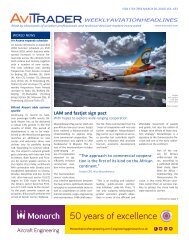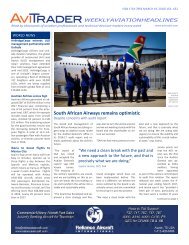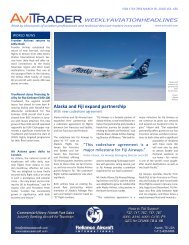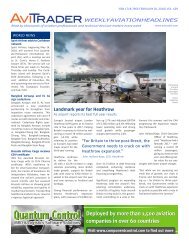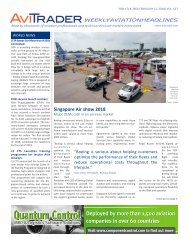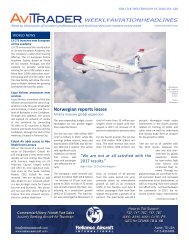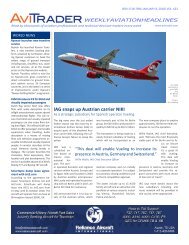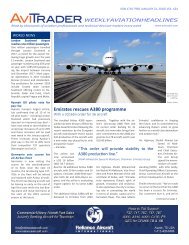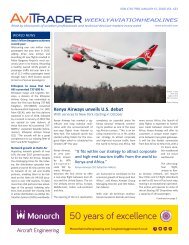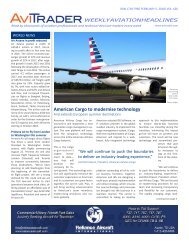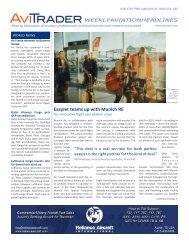AviTrader_Monthly_MRO_e-Magazine_2017-01
AviTrader_Monthly_MRO_e-Magazine_2017-01
AviTrader_Monthly_MRO_e-Magazine_2017-01
You also want an ePaper? Increase the reach of your titles
YUMPU automatically turns print PDFs into web optimized ePapers that Google loves.
ICF Opinion<br />
19<br />
The connected<br />
fleet<br />
Many airlines have outsourced much of the <strong>MRO</strong> on new e-enabled aircraft.<br />
Photo: Boeing<br />
Further implications of aircraft health monitoring<br />
for the aviation supply chain.<br />
Analysis by Richard Brown, Principal, and Alexander Diepeveen, Analyst at ICF Aerospace and <strong>MRO</strong> Advisory<br />
I<br />
t is difficult to avoid a hot topic currently permeating the aviation supply<br />
chain. The issues surrounding big data and aircraft health monitoring<br />
(AHM), data ownership, access and management are increasingly<br />
discussed in industry forums, publications, conferences and<br />
boardrooms. Yet, the benefits and challenges for airlines, OEMs, <strong>MRO</strong>s<br />
and lessors continue to be debated, as does the role of each player in<br />
the AHM market.<br />
ICF examined how e-enablement was disrupting business as usual in<br />
the April 2<strong>01</strong>6 edition of <strong>AviTrader</strong> <strong>MRO</strong>. The arrival of highly connected<br />
aircraft such as the 787, A350XWB and CSeries now allow for<br />
the measurement, storage and transmission of more data from aircraft<br />
engines, airframes and systems than ever before. The opportunities presented<br />
by e-enablement continue apace. It is against this fast-moving<br />
landscape that ICF revisits this important topic.<br />
E-enabled aircraft are on approach<br />
The arrival of e-enabled aircraft brought the promise of increased efficiency<br />
for airlines. OEMs discussed a new way of operating aircraft<br />
– a connected and integrated operation driving increased efficiency<br />
for airlines. The greater availability of maintenance and performance<br />
data encouraged a step-change towards health monitoring. Until recently,<br />
the adoption of aircraft health monitoring services has been slow.<br />
Though health monitoring has been available on aircraft engines since<br />
the 1990s, the benefits beyond the engine to the aircraft systems are<br />
only now gaining traction. The reason for monitoring engines is clear<br />
given the potential to maximize time-on-wing and avoid costly AOGs.<br />
Yet e-enabled aircraft now provide the ability to monitor key aircraft<br />
systems such as avionics and electrical components.<br />
While approximately ~3% of the current fleet is e-enabled, ICF forecasts<br />
that approximately 45% of the fleet (over 15,000 aircraft) will be e-enabled<br />
by 2025. As the connected fleet grows and service offerings mature<br />
to taking advantage of big data, ICF sees operator maintenance increasingly<br />
benefitting from advanced analytics. The heart of the debate<br />
centers on the form the analytics takes and who performs the analysis.<br />
Enter the <strong>MRO</strong>s<br />
With an increasing amount of data, it is likely that only the very largest<br />
operators will develop internal analytical capability. Since the arrival of a<br />
new aircraft type provides operators with an opportunity to change their<br />
maintenance approach many airlines that have traditionally performed<br />
<strong>MRO</strong> in-house have outsourced much of the <strong>MRO</strong> on new e-enabled<br />
aircraft. There is a variety of suppliers for operators to choose from<br />
ranging from the airframe OEMs to integrator <strong>MRO</strong>s and independents<br />
willing to offer <strong>MRO</strong> services often under multi-component cost-perflying-hour<br />
contracts. The growing popularity of maintenance contracts<br />
covering a broad range of component types provides an opportunity<br />
for the maintenance supplier to use data analytics to drive down cost,<br />
increase reliability and ultimately improve the profitability of such service<br />
offerings.<br />
Given the relatively recent arrival of new e-enabled aircraft the advantage<br />
in providing aircraft health monitoring systems has typically resided<br />
with the aircraft, engine and system OEMs. However, more recently major<br />
integrator <strong>MRO</strong>s have also been developing their own offerings. Air-<br />
<strong>AviTrader</strong> <strong>MRO</strong> - January <strong>2<strong>01</strong>7</strong>





